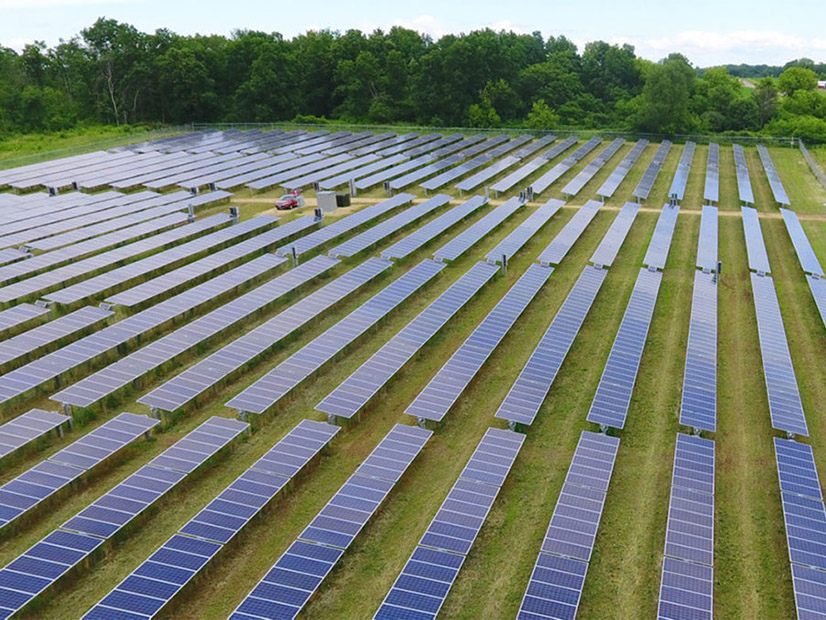MISO continues to suss out a new availability-based capacity accreditation method for renewable generation, despite some stakeholders’ qualms with the early design.
The grid operator held a workshop Wednesday to dissect its proposed methodology for wind and solar resources. It will dole out capacity credit based on a unit’s availability during times of system need.
Jordan Bakke, MISO’s director of policy studies, said the goal is to fit renewable-resource accreditation into the “mold” of thermal units’ recently approved availability-based accreditation. He said MISO must make some assumption adjustments for a “different resource type with different characteristics.”
The RTO is creating “different swim lanes” between thermal, renewable and load-modifying resources, Bakke said.
The grid operator will use a modified effective load carrying capability (ELCC) calculation for renewable resources, then adjust those values for availability based on what it calls “resource adequacy hours,” or historical hours over a year that contain tight supplies and reliability risks.
MISO introduced the concept of resource adequacy hours when it overhauled its ELCC for thermal resources. They represent the top 3%, or 65, riskiest hours per three-month season and include the hours spent in maximum generation events. (See FERC OKs MISO Seasonal Auction, Accreditation.)
“Our bias is to remain somewhat close to what we filed at FERC” for thermal units, MISO planning adviser Davey Lopez said.
Bakke said ELCC is a “comparable method” when compared to thermal generation’s unforced capacity calculation (UCAP).
Clean Grid Alliance’s Natalie McIntire said she didn’t see how the calculations are comparable because UCAP relies on units’ forced outage rates but ELCC doesn’t.
Bakke said the divergence is necessary because wind and solar performance contain a lot of “availability variability” during tight operating periods. On the other hand, thermal output is steadier.
“The performance is much more uniform over time,” he explained.
Bakke said PJM and ISO-NE have made similar arguments to FERC when getting their renewable capacity accreditation designs approved. He said MISO could pursue a more complex calculation only to end up with a “comparable outcome” to the simpler ELCC method. He said MISO isn’t convinced that more labor-intensive number crunching would be worth the effort.
MISO plans on tweaking its current ELCC computation to apply to its ever-expanding renewable fleet.
Renewable energy accreditation will move from being derived using an individual, unit-level ELCC based on peak hour contribution to a resource portfolio-based standard ELCC that will be applied to a unit’s availability during pre-defined resource adequacy hours. Staff said they will create separate portfolio-level ELCCs for wind and solar generation and said they might adjust those based on whether units are located in MISO Midwest or MISO South.
Some stakeholders called the proposed ELCC method difficult to understand. Others said using a fleet-based average is too broad to apply to diverse wind units and will condemn renewable generators to lower capacity values.
Bakke said the portfolio-wide ELCC is “not a wholesale change” but necessary for MISO to have sustainable and consistent renewable accreditation moving forward.
Whether the ELCC should remain an average of unit performance across the portfolio or a become a marginal value, reflecting the capacity value of the most recent renewables additions, remains an open question.
MISO Independent Market Monitor David Patton advocated for a marginal value because he said renewable capacity contributions become less valuable from a reliability perspective as more are added.
“Every conceivable loss of load risk compounds when the wind isn’t blowing; therefore, building more wind at the margins is futile,” Patton explained. “You need more and more capacity for every megawatt you build of an already saturated technology.”
MISO hasn’t yet settled on a marginal versus average approach.
The renewable accreditation won’t cover battery storage or hybrid resources that pair a renewable energy resource with a storage facility. Bakke said MISO wanted to tackle the large amounts of wind, solar and load-modifying resources first before evaluating next year the accreditation of the “more emergent” resource types.
The grid operator has proposed using historical availability data collected from its existing demand-side resource interface to accredit LMRs. It said its control room operators “see a significant reduction in LMR availability when compared to what clears in the PRA.”
Stakeholders have asked MISO to compare the amount of LMRs’ load reduction that is weather dependent during the workday with weekend dependent.

